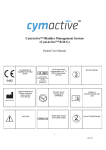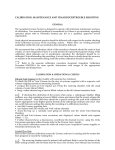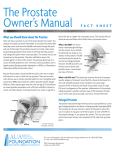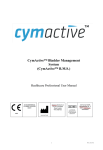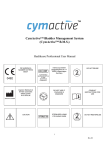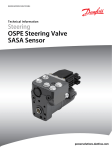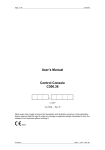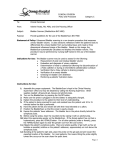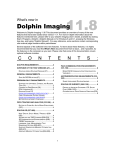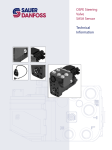Download UDS Troubleshooting Guide
Transcript
UDS Troubleshooting Guide The following information has been provided by Myra Joseph, RN, who is a member of the Society of Urologic Nurses and Associates (SUNA). She currently serves as SUNA’s Urodynamic Special Interest Group Leader and Alamo Chapter President. Myra uses LABORIE UDS equipment. This information reflects her views and experience and is not that of SUNA or LABORIE. At recent SUNA Symposium’s, attendees were asked to complete a survey whose goal it was to provide solutions to common problematic issues that many Clinicians encounter during UDS testing. Following are some of the most common issues that came up, and the answers provided. 1. What is Artifact? There are several different types of artifact when it comes to UDS. Here are a few examples, and how they can be explained on your study. a. Patient kicked the Uroflow cup during the test – If the Uroflow is salvageable, move the Uroflow Start, Stop, and Peak Flow markers to measure the voiding, not the artifact. If it is not salvageable, obtain a mechanical fill at the end of your CMG study. Fill up your patient’s bladder again on ‘Fast Fill’ at the end of the study to the same volume at capacityas on the CMG portion of the study. Confirm the patient has a strong urge to void then switch to the non‐instrumented ‘Uroflow’ test screen. Remove the Pves catheter and allow the patient to voidafter giving the patient ‘Permission to Void’. b. Patient passed gas during my CMG study, causing the Pabd channel to rise – Yes, this will happen. Document the event by adding a comment on rise of Pabd, ‘Patient passed gas’. c. Pves catheter fell out – this can be due to taping. To avoid this in female patients, tape the catheter onto the outer labia and the inner thigh of the patient. Be sure that Pves and Pabd tubing are out of the way when the patient voids. For men, apply a thin strip of tape on the shaft of the penis and run the tape down the Pves catheter. Secure well by folding the tape in half around the catheter. d. EMG Channel is not monitoring correctly –Have the patient move a few inches forward if sitting down. Sometimes when they sit on the seat the EMG patches reflect a solid red line with no recruitment detected when the patient is asked to cough or squeeze. You should always have your patient cough at the beginning of each study to ensure all channels are responding appropriately. Apply tape over EMG patches on female patients, so when she voids the EMG patches do not get wet. This is usually not an issue for males. Add a note on the report if EMG patches get wet (artifact) or if EMG was active or quiet during voiding (synergistic/dyssynergic). Remember – UDS is like telling a story to someone who is not usually present (i.e. physician reading tracings). You want to present a clean study with documented events that tell the story of the patient’s symptoms you are trying to recreate. You want to document what happened during the filling and the voiding phase of the study – you are trying your best to reproduce symptoms but sometimes it is not achieved in spite of your best efforts. 2. What is the difference in zeroing to atmosphere vs. zeroing to patient? The International Continence Society (ICS) recommends zeroing to atmosphere and not to the patient. This means that your baseline before filling will start at the patient’s actual resting pressures. So every patient will have their own unique baseline pressures. When you zero to the patient (which is not recommended) you are taking the patient’s resting pressures (Pves/Pabd) being measured by the catheters and zeroing that number so that their resting pressure has been manipulated. 3. What do you do if the Pves and Pabd channels drift during the filling and voiding phases of the CMG? At the start of the test, the Pves and Pabd channels should be very similar so that the actual bladder pressure (on Pdet channel) is “at or near zero”; Pdet should be between ‐5 and +5. A downward drift of pressures is usually due to a connection problem, or shifting of the position of the catheter. You can always ask the patient to cough and confirm that pressures are responding fully on both channels. If Pves drifts upward, andPabd remains stable then Pdet will rise and it may mean a bladder compliance problem. Mark any artifacts, including things such as peristaltic movement within the rectum, or catheter repositioning.It is not recommended to use the Equalize button during the filling phase of the study as this is artificially correcting the pressure vs. stopping the study and troubleshooting the problem. The equalize button is intended to balance the Pabd pressure at the beginning of c/o LABORIE 2012 This information printed with permission of author for use by LABORIE. 4. the study when it is off by 1‐2 cm H2O after all troubleshooting efforts are exhausted. During the voiding phase, the pelvic floor may relax so much that Pabd goes down slightly. What about Early Sensation due to cool water being used to infuse into the bladder? First, recognize that this is what most patients will feel during the start of the filling phase of the study. Tell your patient that if they feel a cool sensation of water going in to the bladder, this is normal. Then, ask the patient to identify when they feel the First Sensation that there is actually fluid within the bladder (but without a need to actually void yet), then First Desire to void (when they would void at the next convenient moment). Next, have them identify when they feel a Strong Desire to void and lastly, have them identify when they are at Capacity, when they cannot take any more and need to void immediately. Tip: Explain to the patient that when it is time to void, they need to relax and be still so that the pressure generated in their bladder during voiding is measured correctly. Remind them not to talk, push or move during this phase. I recommend playing classical, jazz or contemporary music during procedures – my patients always comment on how enjoyable and relaxing this is. 5. How do you handle nervous patients and what if they are unable to void? a. I play music during my procedures – it helps to relax the patient. I have all kinds of music available and ask the patient what they prefer to listen to. b. I explain to the patient exactly what I am doing and why, using simple terminology, before insertion of catheters. c. If the patient is unable to void, I run water in the sink, dim the lights in the room, leave the room and give them some privacy to void (3‐5mins). Patients have a bell by them to ring when they finish voiding so I may know when to enter the room. This works well most times. d. If patient is unable to void after giving them privacy, I start pulling out the catheters one at a time. Pves is first, if no results, then Pabd, if no results, then EMG patches. If this still doesn’t work, I allow the patient to go into a private bathroom with urinal (for men) or hat (for women) and these patients always seem to void in the bathroom alone. I note that the patient was unable to void until all catheters were removed and note how much the patient voided as well as their PVR. 6. What am I looking for with Urgency or Stress Incontinence? a. Remember when performing a study you are looking to reproduce the patient’s symptoms. With urgency you are trying to demonstrate instability during or at the end ofthe filing phase of your study (i.e. a rise in the Pves channel during the filling phase). b. With stress incontinence you are performing stress maneuvers (cough and valsalva) every 100cc until you see leakage demonstrated (with your eyes). If the patient does not leak and they are sitting, have them stand up and try your maneuvers again with them standing. c. With men who have a diagnosis of Stress Incontinence (Post‐TURP) and do not leak with the Pves catheter nd in place, I recommend you perform a 2 fill. Fast fill them up to their prior capacity, right where they are able to hold it. Remove the Pves catheter and try the stress maneuvers again, using the Pabd catheter as your guide for leak point pressures. 7. Why does the Pdet channel drift down and numbers go negative sometimes? a. At the start of your study you need to make sure your Pdet pressures at rest are ranging from 0‐5 cmH20 before you begin the filling phase. Ideally, starting at zero (on Pdet only)is your goal. b. This may require adjusting the Pves or Pabd catheter by pushing them in more or pulling back some. The Pves catheter may be against the bladder wall, or the Pabd catheter may be caught in a fold of the rectum. c. Make sure there is no stool in the rectum, as this will affect rectal pressures. d. Confirm your catheter is in the bladder by having the patient cough several times. You should see Pves and Pabd both rise at the same level and the number you mark at the peak of the cough on Pves or Pabd should measure very close or exact. Sometimes I have the patient perform a Valsalva maneuver (patient pushes and bears down using pelvic floor), this allows the numbers to rise more gradually and match much better than with coughing. c/o LABORIE 2012 This information printed with permission of author for use by LABORIE. e. Check to see if the female patient has a cystocele. You can count on challenges during these studies and lots of artifact – they may be quite challenging. f. Confirm the bladder is empty at the start of the test. Always measure the PVR by draining the patient’s bladder after voiding and prior to starting the test. If the patient is unable to void fora Uroflow, the amount you catheterize will be referred to as the ‘Residual’. g. Start the pump on ‘Slow Fill’ if you have a patient who has a diagnosis of low capacity bladder or urgency/frequency. Starting the filling too fast may induce instability sooner. h. A patient who comes in with an indwelling Foley catheter has not had their bladder stretched for awhile and usually cannot tolerate much volume. i. If no instability is noted by 200cc on the type of patients mentioned above, you may increase the pump to medium fill. Sometimes Pves and Pabd channel rises or falls in response to different things such as talking, passing gas, etc. As long as theyreturn to baseline so thatPdet is not continuously negative, you are fine. 8. Why do Pabd pressures drift sometimes? a. Stool will affect pressure in Pabd. You may have your patient go to the bathroom to have a BM before you place catheters if they say they need to. b. You may try to digitally remove the stool if the patient is a Spinal Cord patient. Be aware if patient has Autonomic Dysreflexia. I recommend to all SCI patients to do their bowel program the night prior to their UDS study. c. Gas, patient movement, talking, laughing or straining will all cause Pabd artifact. d. When patients begin voiding at Maximum Capacity, Pabdmay drift down as the pelvic floor relaxes. This is normal. 9. How often does my equipment need to be calibrated? Check with your manufacturer for recommendations, or refer to your UDS User Manual. It is probably good practice (and easy to remember!) to CHECK the calibrations on the first day of every month. Actual calibration should only be done if the Calibration Check proves some inaccuracy. L c/o LABORIE 2012 This information printed with permission of author for use by LABORIE.





